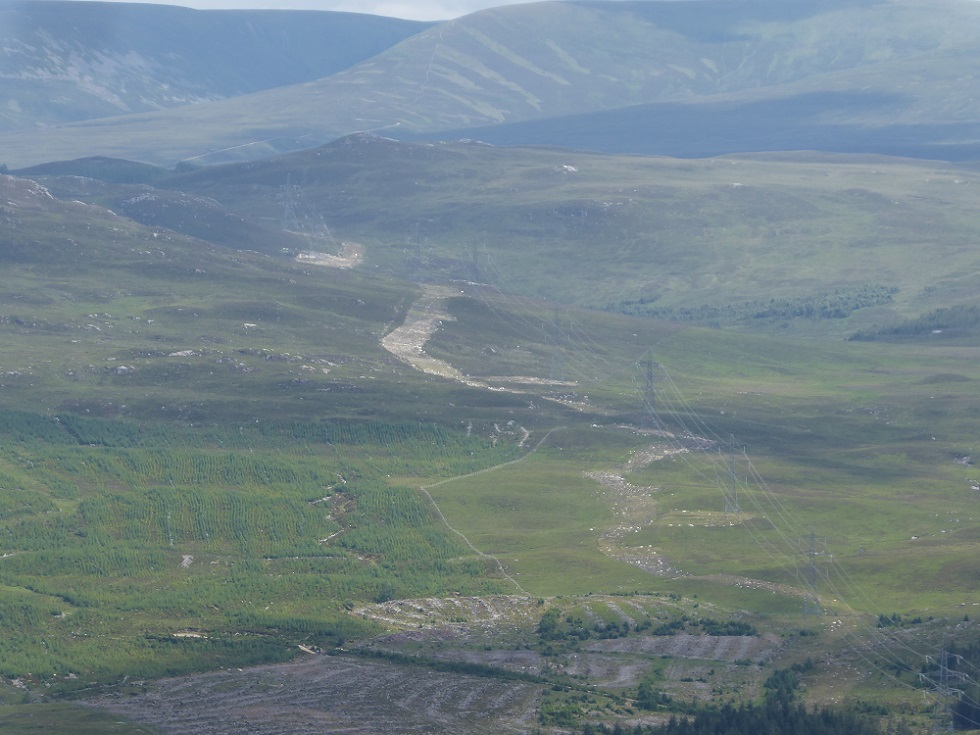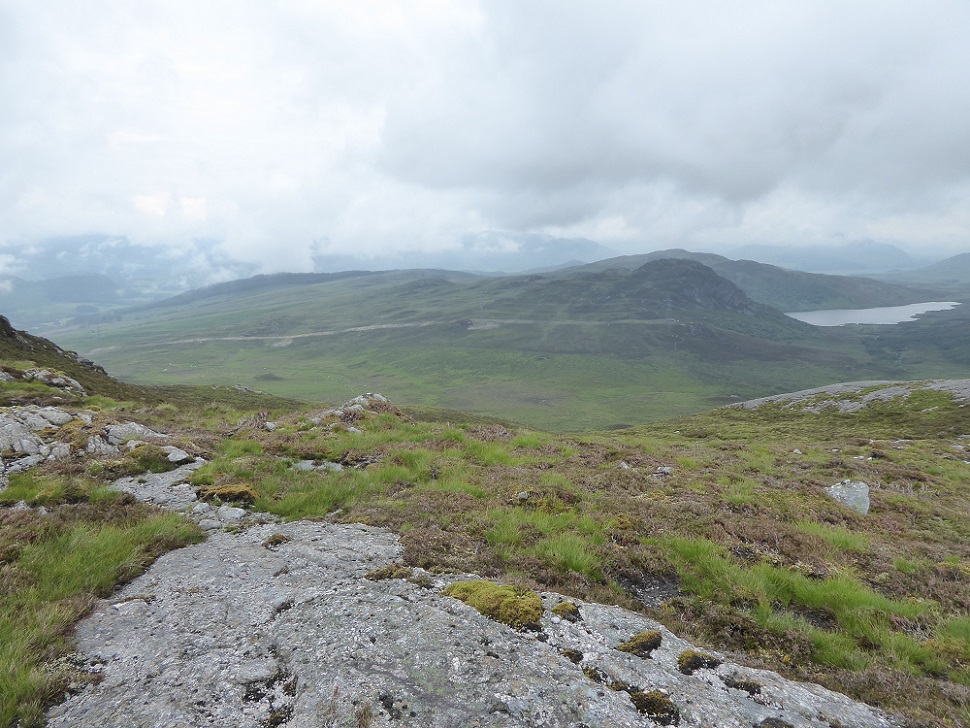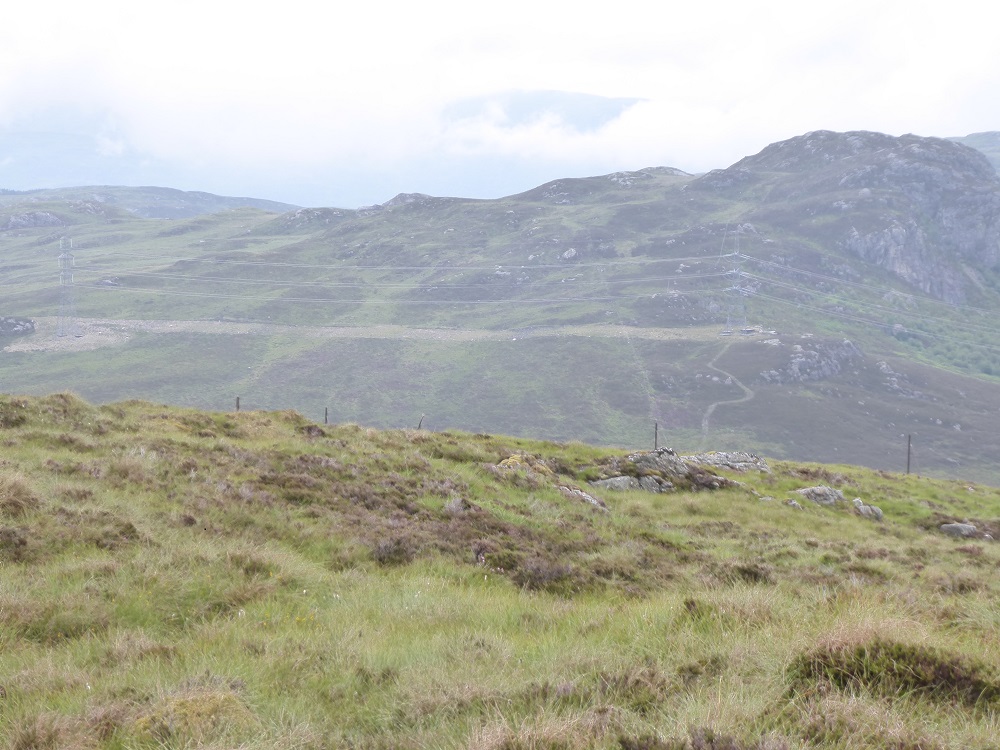
I have looked down on the section of the Beauly Denny which runs between Feagour, in Strath Mashie, to the A9, just north of Dalwhinnine, from two different viewpoints in the last week. Much of this section looks even worse than the scar which disfigures the Drumochter (see here).
Before the Beauly Denny, the powerline traversing the Corrieyairack passed just south of Laggan and, from there,headed almost due east to the A9 before turning south. The new Beauly Denny cut the corner through an area of fairly wild and unfrequented country within the Cairngorms National Park.

It is hard to believe that the temporary construction track needed to be this wide but five and a half years since the powerline went live, the stated intention to restore the ground to how it looked before has clearly failed, and the spin on the SSE website (see here)shown to be just that, spin:
“The Beauly-Denny project had unique conditions associated to its Section 37 consent that required the undergrounding or complete removal of lower voltage overhead. These conditions were imposed upon the project to help reduce the overall visual impact of overhead lines in specific areas including the Cairngorms National Park. The final stages of the Beauly-Denny project required the dismantling of over 600 old towers and reinstatement of access tracks created at the beginning of the project, a significant undertaking which required care and attention.”
The first part of the problem is that SSE, which claims to care for the natural environment, failed to show due care and attention when constructing the access tracks, hence the terrible scars.

The second part of the problem is that none of those responsible for mitigating the destructive impacts of the Beauly Denny development on the natural environment (the Cairngorms National Park Authority, Nature Scot, the Scottish Government and the European Union (see here) have not been prepared to hold SSE to account. The reams of paper setting out mitagatory measures and the assertions to the Public Inquiry that the environmental impacts would be minimised have all been proven to be worthless.
Sadly, money is valued far more than landscape. The short explanation for these photos is that our politicians and public authorities have allowed SSE to sacrifice the landscape to boost profits. Their hope appears to be that nature will, in time, cover up the damage. The photos suggest that may take much longer than the lives of those responsible. Plants will, of course, re-colonise the lines of the access roads over the next few years but the new mineral soils created by the construction work will then support visibly different vegetation communities. The marks on the ground and in the vegetation left by the “temporary” access tracks may well outlast the powerline itself. The Cairngorms National Park Authority, which has a legal duty to protect the landscape, should be very concerned.

A great summary of the environmental damage for which SSE have been responsible and their lack of care in completing restoration. It’s yet another example of a large public service body being allowed to get away with incomplete work by SEPA, SNH and the planning authority.
The SSE spin – I would go much further, and call it misinformation and plain untruths – on the SSE website covering restoration is appalling. It is very clear that restoration work on the access tracks is either incomplete or was not planned correctly to ensure that excavated vegetation could be nurtured and replaced – despite what the website video says. I laughed at the statement that the cable laying machine could lay underground cable as the rate of 15km per day. The removal of pylons and undergrounding of the cables on the section around Boat of Garten took 2 years or more. The excavation involved creation of a works track as wide as a 4 lane dual carriageway, and even now the fields are still getting back to normal. The cost was astronomical – when it didn’t have to be – and was clearly massively overengineered. In 2018 whilst on holiday in Iceland, I noticed the laying of a large mains cable out in the countryside with minimal environmental impact. It involved 3 tracked vehicles working in convoy. The first dug the trench using a large circular disc digger, the second laid the large cable from a massive drum and the third carried out the reinstatement earthworks. If this methodology had been applied on the Boat of Garten stretch, the new cable would have been laid in days – instead of taking 2 years!
I don’t suppose SSE will credit us with any defence or comments – hoping that this botched job will just become yesterday’s news.
This morning in the press we can read of newly announced SSE plans to replace the Fort Augustus to Skye over head power cable system, after it reaches the end of its operational life. The Upgrade is estimated to cost £400 million and may include the “under-grounding” of some more significant “scenic” sections of the route, up grade of redistribution hubs and a reconfiguration of that enormous overhead section that crosses Kyle Rhea.. ( This element on overhead safety grounds alone …has ‘beautifully’ served to totally scupper all wilder dreams of utilising hydro generators there, to harness tidal flows within the narrow, life-line, waterway).
The watching public must raise their guard. No one denies that a 40 year old power distribution system will need replaced. No one can argue that this grid section route is vital to the economy of the western Highlands, both for current needs and future export of small-scale renewable power.with associated loss of potential due to transmission such enormous distances to meet market demand hundreds of miles distant.) ..What must be at issue is creating an atmosphere of really tough planning provisions across the Highlands that will ensure the remote uplands will not suffer a repeat of the casual, wholly dis-interested buck passing lethargy ….now on display over the past 5 years. The disregard towards reinstatement provisions was not predictable. What was entirely predictable were the high levels of environmental damage likely to be inflicted by that project. Scottish Government officers assumed the duty to enforce so many miles of stringent planning conditions. These were deemed so important prior to consent for Beauly – Denny that consent for the project took many years. Since switch on … These same officials have sat on their hands and done too little – if anything- to compel the restoration standard so strenuously promised to the nation. For the newly announced Fort Augustus to Broadford rebuild a further and even higher level of environmental safeguards as firm preconditions are essential. Some special elements must prevent the narrow passage through Kyle Rhea ever being unnaturally constricted by placement of sub-sea tidal arrays and associated high voltage dangers to passing vessels. Development of tidal power in these narrows can only result in more frequent collisions and accidents to those vessels that need to voyage that way.( Local Ferries, fishing craft , but now also larger timber floats, Military craft and fish farm traffic , as well as private yachts) I apologise that this lies outside the present national park areas..but the same environmental standards apply surely.
Thank you for the interesting article.